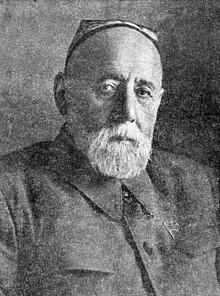
The Tajiks of Uzbekistan are ethnic Tajiks living in the Republic of Uzbekistan. Tajiks make up around 5% of Uzbekistans total population, [1] though this number is belived to be much higher. [2] The third-largest city in Uzbekistan, Samarkand and the major city of Bukhara have a Tajik majority. [3]
History
|
| This section needs expansion. You can help by
adding to it. (July 2024) |
Population
Tajiks are the second largest ethnic group in Uzbekistan since after the fall of the Soviet Union. [4] [5] Tajiks are the majority in the ancient city of Bukhara and in Samarkand, [3] the third-largest city in Uzbekistan. [6] 20.4% of Tajiks live in Surxondaryo Region and 19.9% in Samarqand Region. [7]
| 1926 [8] | 1939 [9] | 1959 [10] | 1970 [11] | 1979 [12] | 1989 [4] | 2017 [5] | 2021 [13] | ||||||||
|---|---|---|---|---|---|---|---|---|---|---|---|---|---|---|---|
| Number | % | Number | % | Number | % | Number | % | Number | % | Number | % | Number | % | Number | % |
| 350,670 | 7.4 | 317,560 | 5.1 | 311,375 | 3.8 | 457,356 | 3.8 | 594,627 | 3.9 | 933,560 | 4.7 | 1,544,700 | 4.8 | 1,657,336 | 4.8 |
The rise in the percentage of Tajiks from 3.9% in 1979 to 4.7% in 1989 can be partly explained by a change in census instructions. In the 1989 census, for the first time, respondents could report their nationality based on their ethnic self-identification rather than their passport. [7]
True Population & Uzbekisation
Due to assimilation pressures that began in 1924 with the creation of the Uzbek SSR, ethnic Tajiks often identified themselves as Uzbeks in population census forms and preferred to be registered as Uzbek in their passports to avoid relocating to the less developed agricultural and mountainous region of Tajikistan. [14] While official Uzbek statistics estimate the Tajik population in Uzbekistan to be around 5%, [15] [1] some expert estimates suggest that Tajiks may actually comprise as much as 25%-30% of the country's total population. [2] Thus the true number of Tajiks in Uzbekistan is unknown.
See also
References
- ^ a b "Uzbekistan", The World Factbook, Central Intelligence Agency, 2024-06-20, retrieved 2024-07-03
- ^ a b Richard Foltz, "The Tajiks of Uzbekistan", Central Asian Survey, 15(2), 213-216 (1996).
- ^ a b "Узбекистан: Таджикский язык подавляется :: Озодагон". web.archive.org. 2019-03-22. Retrieved 2024-07-03.
- ^ a b "Демоскоп Weekly - Приложение. Справочник статистических показателей". web.archive.org. 2010-03-16. Retrieved 2024-07-03.
- ^ a b "Telegram: Contact @statistika_rasmiy". web.archive.org. 2023-02-02. Retrieved 2024-07-03.
- ^ "Samarqand viloyati statistika boshqarmasi". samstat.uz. Retrieved 2024-07-03.
- ^ a b "Ethnic Atlas of Uzbekistan". web.archive.org. 2008-10-06. Retrieved 2024-07-03.
- ^ "All-Union Population Census of 1926". web.archive.org. 2015-02-08. Retrieved 2024-07-03.
- ^ "Демоскоп Weekly - Приложение. Справочник статистических показателей". web.archive.org. 2011-07-22. Retrieved 2024-07-03.
- ^ "Демоскоп Weekly - Приложение. Справочник статистических показателей". web.archive.org. 2010-03-16. Retrieved 2024-07-03.
- ^ "Демоскоп Weekly - Приложение. Справочник статистических показателей". web.archive.org. 2009-12-03. Retrieved 2024-07-03.
- ^ "Демоскоп Weekly - Приложение. Справочник статистических показателей". web.archive.org. 2010-03-24. Retrieved 2024-07-03.
- ^ "Permanent population by national and / or ethnic group, urban / rural place of residence". web.archive.org. 2023-02-02. Retrieved 2024-07-03.
- ^ Rahim Masov, The History of the Clumsy Delimitation, Irfon Publ. House, Dushanbe, 1991 (in Russian). English translation: The History of a National Catastrophe, transl. Iraj Bashiri, 1996.
- ^ "Population". web.archive.org. 2008-06-20. Retrieved 2024-07-03.
This article has not been added to any content
categories. Please help out by
adding categories to it so that it can be listed with similar articles. (July 2024) |